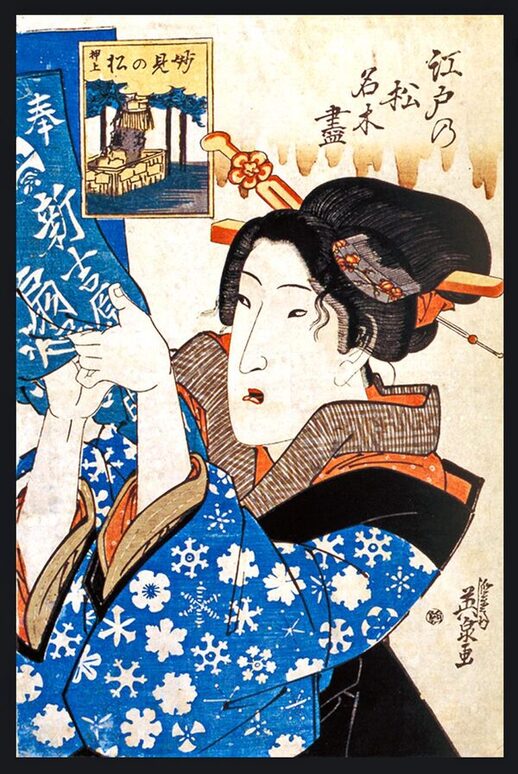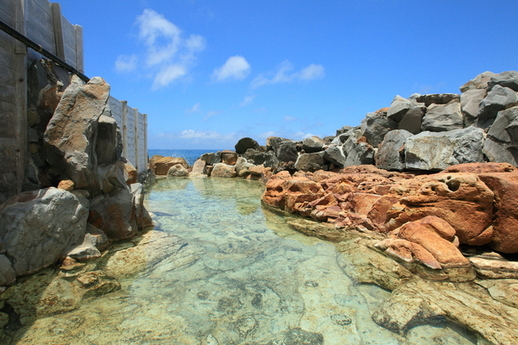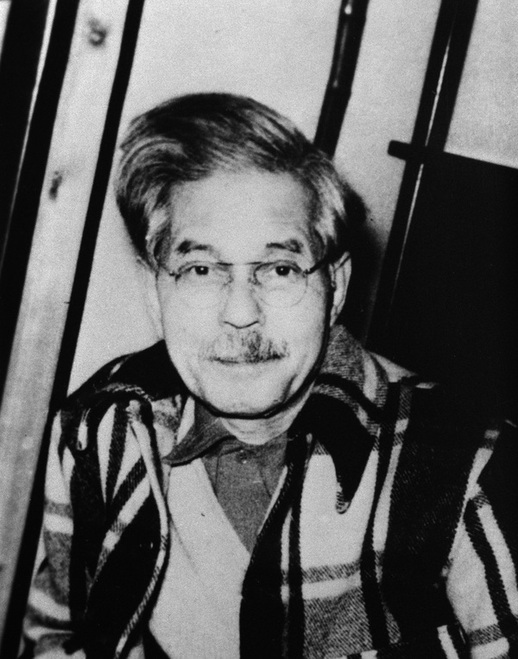2024.12.12
伝検通信(メルマガ)週刊メールマガジン「伝検通信」 第37号
週刊メールマガジン「伝検通信」第37号をお届けします。
今週のトップ記事は、江戸時代の殿様が見つけた「雪の結晶」が着物の柄に影響をもたらしたという話題です。
「クイズで肩慣らし」は、前回クイズの答え・解説と、温泉の問題です。1月末までの第1回検定期間中は同試験の出題対象から外し、伝統文化に関するさまざまな問題をお届けします。
現在実施中の2級および3級の第1回伝検の受験は下記サイトから申込みできます。公式テキスト、2級受験者向けオンライン講座も販売しています。
伝検申込サイト https://denken-test.jp/examination/
目次
・ 「雪の殿様」が生んだ江戸の流行
・ 「クイズで肩慣らし」第36回=「温泉」
・ 伝検協会だより
「雪の殿様」が生んだ江戸の流行
武部 隆 時事通信ブランドスタジオ社長

雪華模様の着物が描かれた浮世絵「江戸の松名木尽 押上 妙見の松」
(渓斎英泉作、古河歴史博物館蔵)
「雪華(せっか)」という雪の結晶の文様をご存じでしょうか。名付け親は徳川家に縁のある土井利位(どい・としつら)という殿様です。利位は文政5年(1822)、下総国古河(現在の茨城県古河市)を本領とする古河藩・土井家の11代目当主となりました。土井家は徳川家康の従弟(いとこ)だった利勝を祖とする譜代大名で、利位も奏者番を皮切りに大坂城代、京都所司代と幕府の重職を務め、天保10年(1839)、本丸老中に列しました。天保14年(1843)には、天保の改革に行き詰まって失脚した水野忠邦に替わり、老中首座に任じられています。
利位は幕政を取り仕切る政治家としての能力を発揮する一方、自然科学を探求する博物学者という変わった一面を持っていました。オランダから入手した顕微鏡を使い、空から降る雪の結晶を自ら観察、さまざまな形態の結晶を絵に描いて記録に残したのです。そして、その研究成果を「雪華図説」という解説書にまとめ、天保3年(1832)に刊行しました。雪の結晶の存在を世に知らしめ、それを「雪華」と名付けたのは、博物学者としての利位でした。
雪華図説は私家版として少数しか印刷されず、一般にはほとんど流通しませんでした。ところが、その5年後に江戸でベストセラーとなった博物書「北越雪譜」に雪華図説の雪の結晶図が引用されたことをきっかけに、江戸っ子たちの注目を集めました。
実は、江戸の庶民は現代よりもファッションに敏感でした。江戸時代中期以降、都市の町民が経済力を付け、それまでは武士の特権のようなものだった花見や旅行などの娯楽や行事が庶民にも広まりました。娯楽や行事には「よそゆき」の着物が必要で、そこに江戸っ子の「粋(いき)」を見せたいと誰もが思ったのです。
着物の柄、今で言うテキスタイルパターンは、着る人のセンスが反映されます。その当時、定番とされた棒縞(ぼうじま)、千筋(せんすじ)などのしま模様、弁慶格子(べんけいごうし)、子持格子(こもちごうし)といった格子模様、鮫小紋(さめこもん)、行儀小紋(ぎょうぎこもん)に代表される小紋柄などのパターンには多種多様なアレンジが施され、江戸っ子は着物の柄で粋を競いました。
常に斬新なパターンを追い求めていた江戸の服飾業界は、雪華図説で描かれた雪の結晶に飛び付きました。六角形を基本としながら、決して同じものはできないという結晶の多様性に加え、手に取れば一瞬で溶けてしまう雪のはかなさも、日本人の美意識に突き刺さったに違いありません。天保の江戸を、雪の結晶をモチーフにしたテキスタイルデザイン「雪華模様」が席巻した事実は、当時の浮世絵で雪華模様の着物を着た人物が多く描かれたことでも裏付けられます。
江戸の庶民は、雪の結晶のデザインを世に広めた土井利位に敬意を示すことも忘れませんでした。雪華模様の別名「大炊模様(おおいもよう)」は、利位の官名が「大炊頭(おおいのかみ)」だったことに由来します。かつて土井家が治めた茨城県古河市でも、利位は「雪の殿様」として市民から親しまれ、今も町のあちこちで雪華模様のデザインを見ることができます。
「クイズで肩慣らし」第36回=「温泉」
~第1回検定期間中のクイズは同試験の出題対象から外します。またテキストの分野以外からも取り上げます~

第36回
問題:寒い季節になりました。飛鳥時代から歴代の天皇や多くの貴族が癒やしを求めて訪れ、日本書紀や万葉集にも登場する温泉地はどこでしょうか。(答えと解説は次号で)

独自の模様を考案した陶芸家。「色絵磁器」で人間国宝として認定された(写真/時事)
【前回の問題と答え・解説】
問題:明治時代から昭和時代に活躍した陶芸家で、「模様より模様を造るべからず」という言葉に象徴される独自の模様を考案し、「色絵磁器」で人間国宝となった人物は誰でしょうか。
答え:富本憲吉
解説:イギリスのデザイナー、ウィリアム・モリスの影響を受け、同国の陶芸家バーナード・リーチとも交友を深めました。四弁花(しべんか)模様・羊歯(しだ)模様といった独自の文様を生み出し、自らの手で素材に挑むことで陶芸を自己表現と捉えていました。1955年、最初に人間国宝に選ばれたうちの1人です。
伝検協会だより
▼弊会の境克彦理事長が12月18日(水)、ラジオ日本(AM 1422kHz)の平日朝のニュースワイド番組「岩瀬惠子のスマートNEWS」(午前6時30分~同8時50分)に生出演します。境理事長の登場は午前8時15分から15分の予定。伝検について、パーソナリティーの岩瀬さんからインタビューを受けます。是非、ラジオまたはインターネットのradikoでお聞きください。
▼東京大学卒業生・現役学生らで構成する知識集団、
▼伝検公式テキストの初版第1刷がほぼ完売となりました。ご購入いただいた皆さまにこの場を借りて御礼申し上げます。また、ご購入希望の方にはご不便をお掛けし、心よりお詫び申し上げます。12月20日に第2刷を発売いたしますので、しばらくお待ちいただきたくお願い申し上げます。年明けの1月上旬には電子書籍も発売予定です。
編集後記
第1回伝検は、CBT(Computer Based Testing)と呼ばれるコンピューターを用いた方式で試験が行われるため、その場で結果が分かります。すでに合格者も出ているとのことです(すごいです!)。合格者の方々への特典もあります。ぜひ1月末までの試験中に奮ってトライしてみてください。
【English version】
Weekly e-mail magazine “DENKEN TSUSHIN” No. 37
We are pleased to present the 37th issue of our weekly e-newsletter “Denken Tsushin.
This week's top article is about a snowflake found by a lord in the Edo period that influenced kimono patterns.
In the “Let's Practice with Quizzes” section, you will find the answers and explanations to the previous quiz and a question about hot springs, which will be removed from the exam during the first examination period until the end of January.
The first DENKEN examinations for Level 2 and Level 3, which are currently being conducted, can be applied for at the following website. Official textbooks and online courses for Level 2 examinees are also available.
DENKEN application site: https://denken-test.jp/examination/
Table of Contents
・Edo's fashion trend created by “Lord of Snow
・Let's Practice with Quizzes with the history of the Edo period
・From DENKEN KYOKAI
Edo Fashion Trend Born of “Snow Lord
Takashi Takebe President, Jiji Press Brand Studio

Ukiyoe “Edo no Matsu Meiki Zetsu Oshiage Myoken no Matsu” (Pine trees and famous trees in Edo, Oshiage Myoken no Matsu) with a kimono with snowflake pattern.
(By Eisen Keisai, owned by the Furukawa Museum of History)
Have you ever heard of the snowflake pattern called “Sekka”? Its godfather was a lord named Toshitatsura Doi, who was related to the Tokugawa family. In 1822, Toshiki became the 11th head of the Doi family of the Furukawa domain, whose main domain was Furukawa in Shimousa Province (present-day Furukawa City, Ibaraki Prefecture). The Doi family was descended from Toshikatsu, a cousin of Tokugawa Ieyasu, and Toshiki held important positions in the shogunate, starting as a Kanadeban, then as a representative of Osaka Castle, and finally as a representative of Kyoto. In 1843, he replaced Tadakuni Mizuno, who had lost his post after the Tempo reforms stalled.
While Toshinori demonstrated his ability as a politician in charge of the shogunate, he also had an unusual aspect: he was a naturalist who explored the natural sciences. Using a microscope he acquired from the Netherlands, he observed snow crystals falling from the sky, and drew pictures of the various forms of crystals to record his findings. He then compiled the results of his research into a commentary entitled “Illustrated Description of Snow Crystals,” which was published in 1832. It was Ritsui, as a naturalist, who made the existence of snow crystals known to the world and named them “sekka” (snowflakes).
Seikka Zusetsu was printed in a small number as a private edition and was rarely circulated to the general public. However, five years later, the snow crystal illustrations from the Yukika Zusetsu were quoted in the best-selling natural history book “Hokuetsu Yukifu,” which attracted the attention of the Edo people.
In fact, the common people of Edo were more sensitive to fashion than today. From the mid-Edo period onward, urban townspeople gained economic power, and entertainment and events such as cherry blossom viewing and travel, which had previously been the privilege of the samurai, became popular among the common people. For entertainment and events, “outing” kimonos were necessary, and everyone wanted to show the “iki” (iki) of the Edo people.
Kimono patterns, or textile patterns as they are called today, reflect the sense of the wearer. The standard patterns of the time, such as striped patterns like Bo-jima and Sen-suji, plaid patterns like Benkei-goushi and Komochi-goushi, and komon patterns represented by Same-komon and Gyogi-komon, were arranged in a wide variety of ways, and the Edo The Edo children competed with each other in kimono patterns.
The Edo clothing industry, which was always in pursuit of novel patterns, jumped on the snowflakes depicted in the Yukika Zusetsu. In addition to the diversity of crystals, which are based on hexagons but are never identical, the transience of snow, which melts in an instant when picked up, must have struck a chord with Japanese people's sense of beauty. The fact that textile designs using snowflakes as motifs, known as “Yukikamon,” swept through Edo during the Tempo period (1600-1868) is supported by the many depictions of people wearing Yukikamon kimonos in ukiyoe prints of the time.
The common people of Edo also did not forget to show their respect to Doi Toshinori, who introduced the snowflake design to the world. The name “Oimoyo,” also known as the snowflake pattern, derives from the fact that Toshikazu's official name was “Oimokami,” which means “head of the Oimono” (the head of the Oimono family). In Koga City, Ibaraki Prefecture, where the Doi family once ruled, Toshinori was known as “Lord of Snow” by the citizens, and the Yukika pattern can still be seen here and there in the city.
Let's Practice with Quizzes with the “Onsen” (Hot Springs)
~Quizzes taken during the 1st certification test will not be included in this test. Quizzes from other fields than those covered in the textbooks will also be included.

The 36th
Question: It is the cold season. Which hot spring resort has been visited by emperors and many aristocrats for healing since the Asuka Period and is mentioned in the Nihonshoki and Manyoshu? (Answers and explanations will appear in the next issue.)

A potter who invented unique patterns. Recognized as a Living National Treasure for his “Iroe Porcelain” (photo/Jiji)
Previous Question and Answer / Explanation
Question: Who was the potter active from the Meiji Era to the Showa Era who invented the unique pattern symbolized by the phrase “Never make a pattern out of a pattern” and became a Living National Treasure for his “Iroe porcelain”?
Answer: Kenkichi Tomimoto
Explanation: Influenced by the English designer William Morris, Tomimoto was also a friend of Bernard Leach, an English potter. He was one of the first to be designated a Living National Treasure in 1955.
From DENKEN KYOKAI
▼Katsuhiko Sakai, President of DENKENKYOKAI, will appear live on Radio Japan's (AM 1422 kHz) weekday morning news wide program “Keiko Iwase's Smart NEWS” (6:30 am to 8:50 am) on Wednesday, December 18, 2012. President Sakai's appearance is scheduled for 15 minutes starting at 8:15 am. She will be interviewed by Ms. Iwase, the personality on the program, about Denken. Please listen to the radio or internet radio station radiko.
▼ QuizKnock, a knowledge group consisting of graduates and current students of the University of Tokyo, has released a video challenging Denken. The title of the video is “Can the Quiz Kings Pass a ‘New Test’ on Their First Attempt? The title of the video is “Japanese Traditional Culture Test. Please take a look.
▼The first printing of the first edition of the official text of Denken has almost sold out. We would like to take this opportunity to thank everyone who purchased a copy. We will be releasing the second printing on December 20, so please be patient. An e-book will also be available in early January.
Editor's Postscript
The 1st DENKEN is administered by a computer-based method called CBT (Computer Based Testing), so the results are known on the spot. Some people have already passed the test (amazing!). ), and there are also special offers for those who have passed. There are also special offers for those who pass. Please get excited and try during the exam until the end of January.
カテゴリー: 伝検通信(メルマガ)





